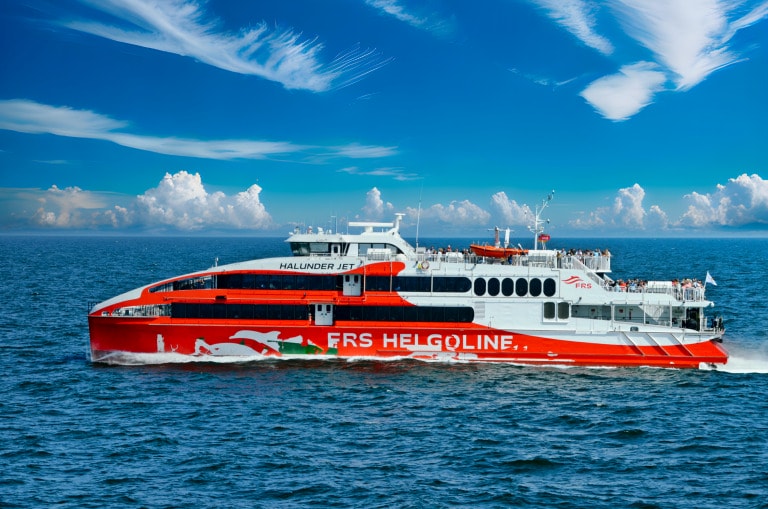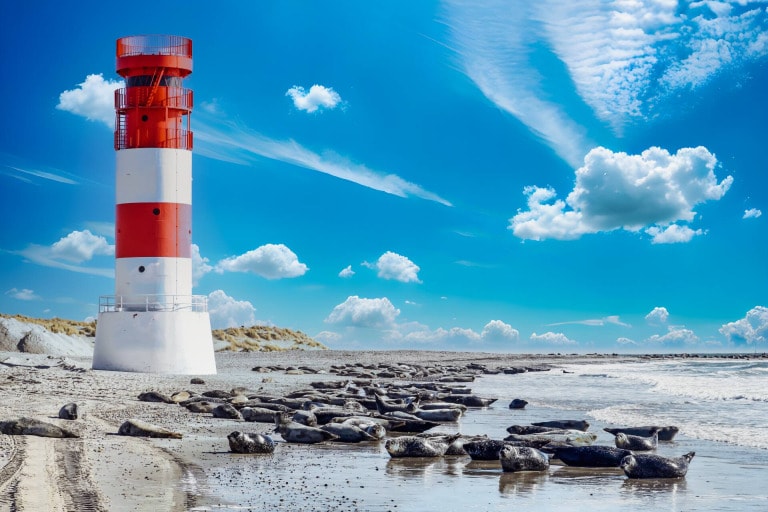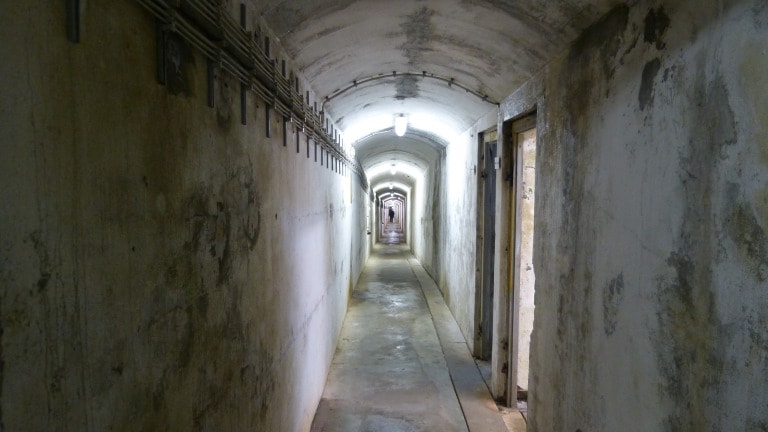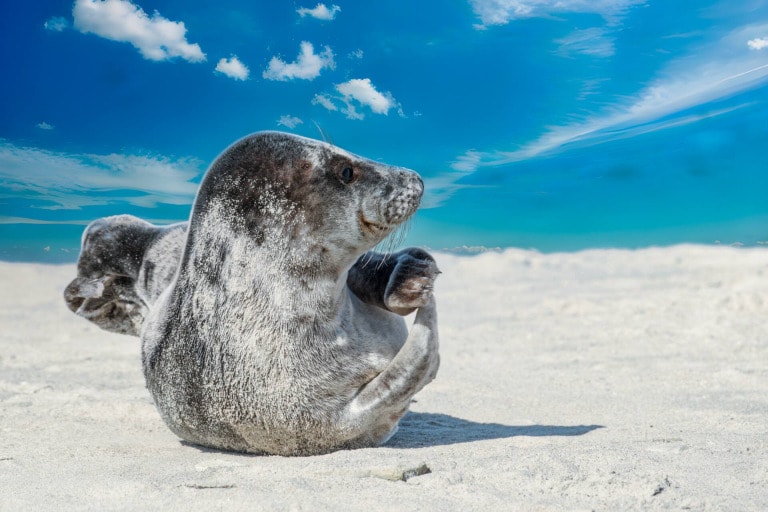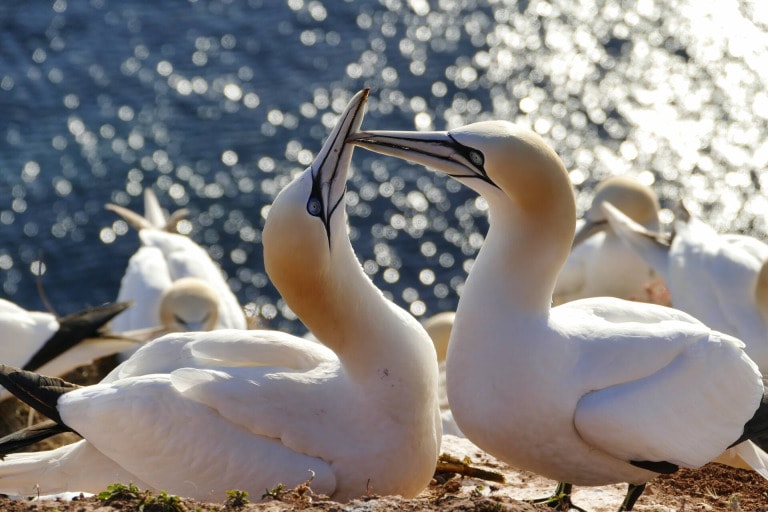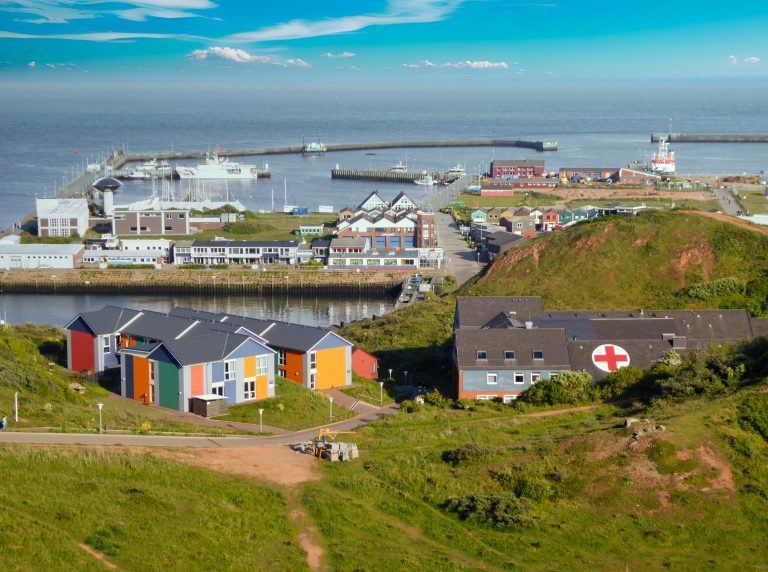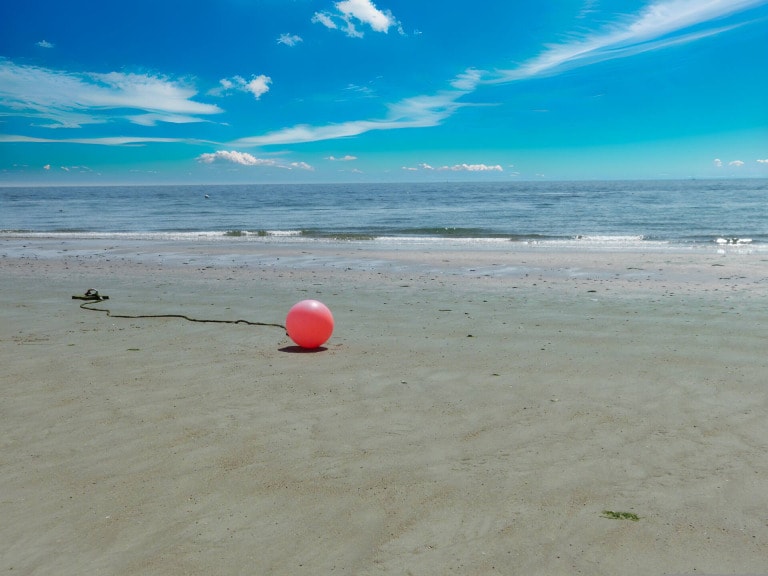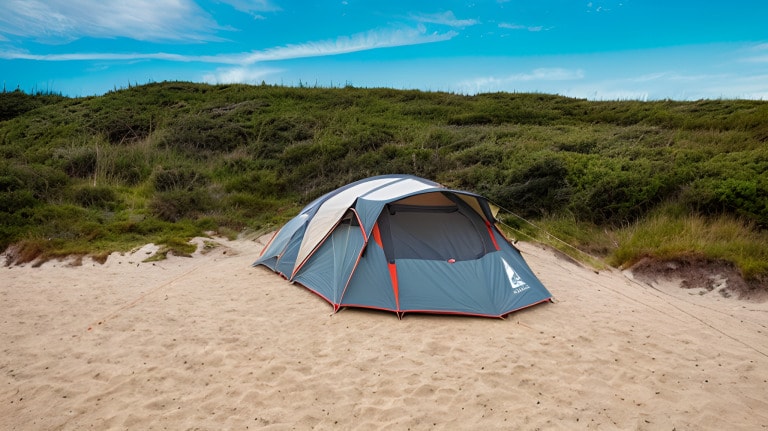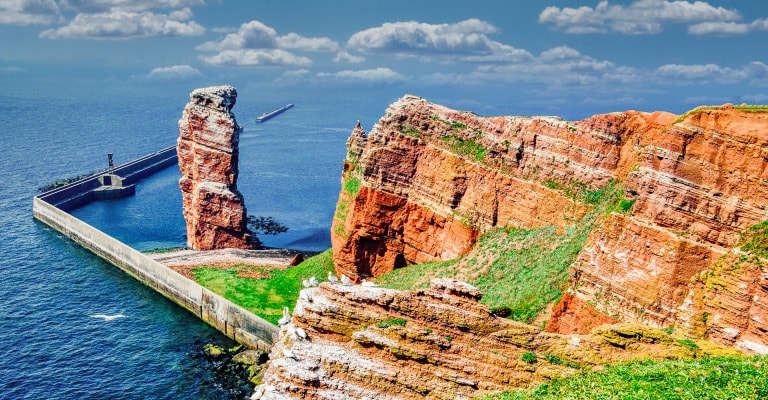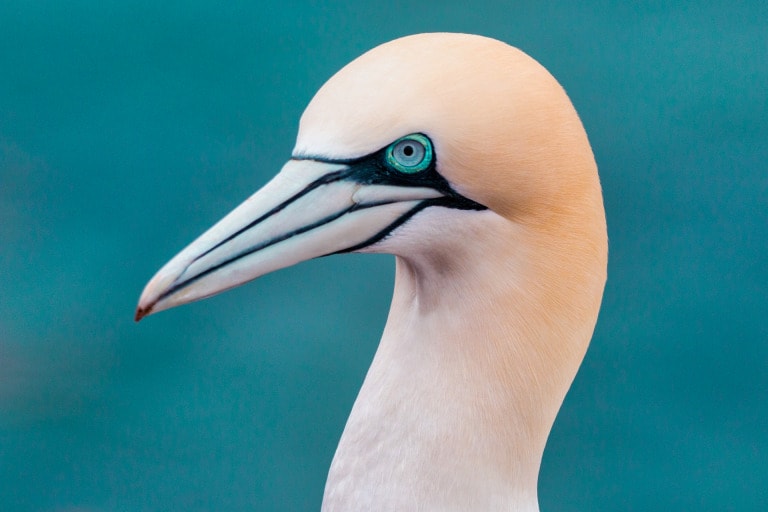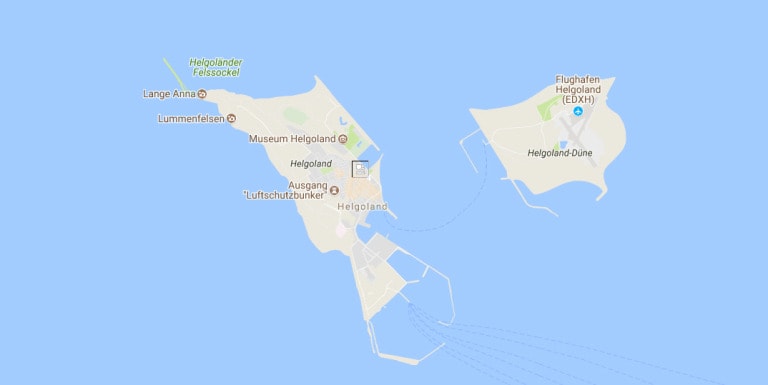The museum also regularly organizes exhibitions and information events for North Sea-vacationers and locals. In addition to the actual building, the museum also includes the museum courtyard and the bunkers in the upper part of the island.
Museum opening hours
The museum is open to visitors daily from 10 am to 2:30 pm. Only on New Year's Eve and New Year's Day it closes its doors.
Admission costs € 4 for adults, € 2 for children. There are discounts for groups of twelve people or more.
Note for wheelchair users: Not all areas of the museum are accessible by wheelchair.

The Heligoland Bunker
Thematic areas in the museum
The themes of the museum all revolve around the history of the Heligoland island. Both the natural science collections and artists are all related to the High Seas Island.
Art history and cultural history - these are the two areas on which the Museum Helgoland focuses. The focus is always on the connection with the island of Helgoland. The museum wants to act as a memory of the North Sea island be perceived. The museum, museum courtyard and bunker facilities form a single unit, and the exhibitions are grouped under the concept "Authentic Homeland Worlds".
Biological research on Helgoland
Helgoland was the destination of researchers as early as 1835: The sea light around the island had attracted the naturalist Christian Gottfried Ehrenberg.
He proved that it was caused by a tiny single-celled organism. Ten years later, Johannes Müller founded plankton research on Helgoland. The North Sea was also the focus of research in the following period. In 1892, the Prussian Ministry of Culture named Helgoland the Royal Biological Institute - whereupon Helgoland developed into a recognized location for marine biological research. The Second World War completely destroyed the Biological Institute. It was not reopened until 1959.
Pioneer of photography: Franz Schensky
He was one of the most important black-and-white photographers in the world: Franz Schensky from Helgoland. The Museum Helgoland has rediscovered 1,400 original picture plates and had them developed for the public. Many of his motifs deal with the sea and the island. It is also thanks to his photographs that Helgoland is now known beyond the borders of Germany.
Through his photos he became a chronicler of the island's history. Thus, pictures from 1890 show the handover ceremony of Helgoland from England to the German Empire. He also documented the destruction of the island during World War II and the beginnings of its reconstruction in 1952. He received several national and international awards for his pictures. More than 50 gold medals are now in the possession of the museum and can be viewed.
Geology & Fossils on Helgoland
Millions of years ago, the island of Helgoland lay in the Zechstein Sea. This evaporated over time due to climate changes, leaving sediments as a residue.
These sediments reached a thickness of more than one kilometer - the visible part of Helgoland is a part of it. From this and later times come many fossils that can be seen in the museum. Among them are ammonites, shells, fish and even marine dinosaurs.
But not only the fossils are worth seeing: red flint was found on Helgoland. The red coloration is caused by the high content of iron oxide. Flint was formed about 88 million years ago and is thus still quite young, compared to amber. This fossil resin can be up to 260 million years old. Amber is mostly made of the resin of trees, which has hardened over the years. Sometimes plants or even animals are included in the resin and become fascinating witnesses of days long gone.
Halunder - the language of the Helgoland people
If you want to spend your vacation on the North Sea island Helgoland, you may have already heard it: Halunder, the old language on Helgoland.
Helgoland Frisian is now spoken by fewer than 1,000 people. To keep the dialect alive, it is even taught at school - and is the island's official language alongside standard German. Unlike many other North Frisian dialects, Halunder has adopted few Danish influences. Rather, it resembles Low German.
Marriage on the island of Helgoland
Dreamlike scenery, beach and the sound of the sea: For many people Helgoland is not only an ideal place to Vacation at the North Sea but also to get married.
And not just recently. As early as 1900, visitors came to Helgoland to get married on the North Sea island - often quietly and without guests.
The connection of wedding with a Vacation at the North Sea was also so popular because no six-week banns had to be kept and also the nationality of those wishing to marry was not important - unlike on the mainland. You can get married in the museum courtyard: two lobster huts are available to the registry office as wedding rooms. Afterwards, there is the possibility to quite literally "enter the harbor of marriage" with a boat.
The island of photography
Helgoland is rich in picture motifs. Not only the court photographer Franz Schensky appreciated this. In addition to the collection of more than 1,000 photographs by the famous photographer, the museum frequently hosts temporary exhibitions by other artists. For example, there have already been exhibitions about ice landscapes in the Antarctic and a photographic journey with a camera obscura through Schleswig-Holstein.
Influenced by his native Helgoland: James Krüss
Probably the most famous son of Helgoland is the writer James Krüss. Born on the island in 1926, he was evacuated from Helgoland as a teenager during the Second World War along with all the other children.
At the age of 20, he published his first book, which was still aimed at adults. In the same year, he began studying to be a teacher. He graduated two years later, but never worked in the profession.
Instead, he founded the magazine "Helgoland," which was aimed primarily at people displaced from the island. On the advice of Erich Kästner, he began writing books for children and young people. But he was not only creative in book form: he wrote texts for picture books, plays, developed radio plays and hosted television programs. His best-known book is probably Timm Thaler or The Sold Laughter, but his other works, such as the picture book Henriette Bimmelbahn, are still popular reads today. After his death on Gran Canaria, his ashes were scattered in the sea near Heligoland.
Military history of the island
The North Sea island of Helgoland has a strategically important significance. After being occupied by British troops in 1807, it remained under their occupation until 1890. In that year, the island fell into German possession.
In the following years, Helgoland became an important port for the imperial navy. Commander-in-chief Kaiser Wilhelm II engaged in a fleet arms race with the British navy and continued to stock up.
The military construction activities on Helgoland were once again pushed forward with the beginning of the National Socialist rule in 1933. Thus, an extensive air raid protection tunnel system was built under the Oberland. The "lobster claw" project was also important to the Navy commanders. Under this name, they wanted to create a harbor north of the dune for the entire German fleet. In addition, the island was to be greatly enlarged by sand flushing. After the preliminary work, this project was no longer pursued. Nevertheless, it had an impact on the island. Thus, the dune and the island in the northeast actually increased in size.
The military installations and civilian buildings were destroyed after the war and the island became uninhabitable. From 1947 to 1952 it was used by the British Air Force as a site for bombing.
Postal history on Helgoland
Due to its location, Helgoland has always been an important port of call for ships of nations engaged in maritime trade. The conquest of Helgoland by various countries also had an impact on the postal service.
Thus, in the course of history, there have been Danish, English and German stamps and postmarks on Helgoland. The relationship with Hamburg is special. Still in Danish possession, a Hamburg postal agency was established in 1796. In 1867, the first "Helgoland postage stamps" were introduced by the British postal administration. Even after the handover to the Empire, Helgoland was frequently printed on stamps.
With the takeover in 1890, the Royal British Post Office became an Imperial German Post Office.
Strengthen pleasure and health: seaside resort Helgoland
Helgoland has a long tradition as a seaside resort: as early as 1826, Jacob Andresen Siemens built a bathing establishment on the dune. The number of visitors increased rapidly; in 1838, more than 1,000 guests already visited the island. At that time, a visit to a seaside resort was reserved and valuable only for those of high social standing.
The bathing itself was different from a beach vacation today: The guests were pulled into the knee- to waist-high water in bathing carts. Separated by gender and with much consideration for privacy, guests could now climb stairs into the sea. But they did not swim - the bathers only dipped into the water a few times to refresh themselves and strengthen their circulation. The Vacation at the North Sea became increasingly popular: by the turn of the century, well over 10,000 tourists came to bathe. The development was promoted by the British governor Sir Henry Maxse, who supported the various facilities.
The up-and-coming vacation region was interrupted by the two world wars. After the reconstruction, the number of tourists continued to rise and in some years up to 800,000 people visited Helgoland. In the meantime, visitor numbers have declined. According to official figures, only 300,000 guests came to Helgoland in 2009 and 2010.
Rescue at sea: help for survival
Anyone can get into distress at sea - that's why sea rescue is important for everyone in the waters. During operations, rescuers not only help those in distress at sea, but also secure ships or transport sick people from the island to the mainland.
Especially on Helgoland a station was important, because the island is located near busy shipping lanes. In the beginning, the rescuers rowed in small boats to the ships in distress. In 1892, the Helgoland sea rescuers received a boat that was adapted to the sea conditions around the island. Today, the 46-meter-long Hermann Marwede is ready for action at any time.
The stone box tomb
Discovered, removed, forgotten, rediscovered: The Helgoland stone box grave from the Bronze Age has had an eventful history.
It was excavated on Helgoland as early as 1893 and brought to Berlin to the Martin-Gropius-Bau. During the Second World War, this was destroyed and the documents about the stone box tomb were lost. It was only rediscovered in 2008 and is now in the Neues Museum in Berlin - right next to Egyptian sarcophagi. Since 2014, a replica of the stone box tomb has been in the Museum Helgoland. On old maps of the island, there are more mound tombs recorded.
But even extensive searches have so far failed to turn up any of them - they have probably been destroyed by storm surges over the centuries.
Brave men in the Second World War: Helgoland resistance
During the Second World War, Georg Braun and Erich Friedrichs forged a plan for the peaceful surrender of Helgoland to the Allies. While Braun dealt with soldiers and officers, Friedrichs' inn was mainly frequented by civilians.
Frederick had made contact with the English via radio. The two subgroups could only exchange information secretly. Shortly before they could put their plans into action, they were betrayed by two members of the group. Five members of the group were convicted in a summary trial in Cuxhaven and executed on April 21, 1945.
The island with a cellar: Bunker facility on Helgoland
Since the Nazis seized power in 1933, bunkers several kilometers long were driven into the island on Helgoland. The tunnel system of the Oberland and the Unterland were interconnected. This created a branching network of corridors and a large room system.
In 1947, a huge explosion was to destroy the island's bunker facility. The detonation is considered the largest non-nuclear blast in the world. Only years later the first inhabitants could return to the island. The remaining bunkers can be visited. The tour lasts about an hour and takes place Monday through Saturday at 4:30 p.m. and Tuesdays, Saturdays and Sundays at 10:00 a.m.
If you have a problem with your Vacation at the North Sea would like to experience a bunker tour, please register in advance.
What will change as a result of the new building?
The museum houses the most comprehensive collection about the island of Helgoland. As this can no longer be properly presented in the existing building, a 300 square meter extension is to be built. The exhibits are to be reorganized for this purpose. The bunker facilities are also to be further developed in this move. The new building is being funded by the EU, the state of Schleswig-Holstein and the municipality.
The museum yard - a world of its own.
In 2006, a museum courtyard was built on the museum's outdoor area. So-called lobster stalls were set up there. The booths provide in-depth information on Helgoland's cultural history - for example, on James Krüss, postal history or the photographer Franz Schensky. Some lobster stalls are made available to artists as studios.
In addition, in the courtyard there is a model of a 12,000 lbs bomb from World War II. Such bombs were dropped on Helgoland in 1945. One building in the museum courtyard towers above all others: the lighthouse. The island's first beacon was built around 1630. Today, the lighthouse is still involved in securing shipping through modern radar technology. The model in the museum yard was completed in 2009.
How it all began... The history of the museum
The museum itself also has an eventful history: it was founded as early as 1897 and opened in 1899 after two years of construction. The focus of the museum was natural sciences. The first exhibits were taxidermied birds and a collection of algae. The sponsor of the museum was the Royal Biological Institute of Helgoland. During a major attack on Helgoland in 1944, the museum was almost completely destroyed. It was not until 1996 that the new museum was founded as part of the Stiftung Nordseemuseum Helgoland.
You would like to promote the museum?
The Förderverein Helgoland e. V. has existed since 1981. The association, which is registered under tax law as worthy of support, supports the expansion and development of the museum. Members of the association receive free admission to the museum and invitations to all openings and events.
More information at:


